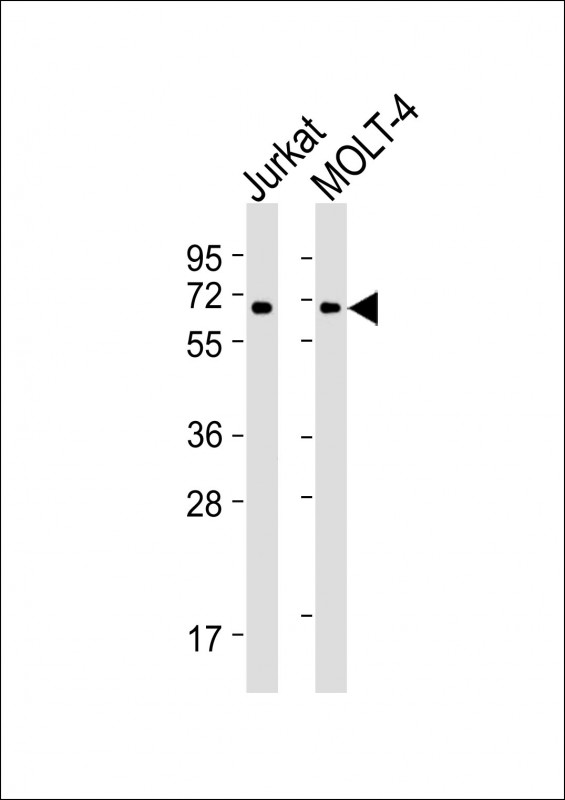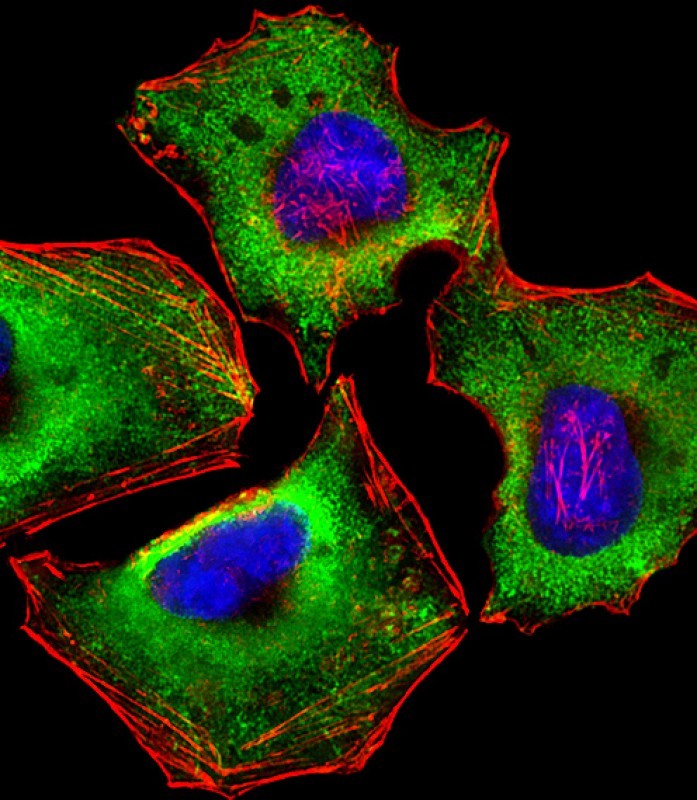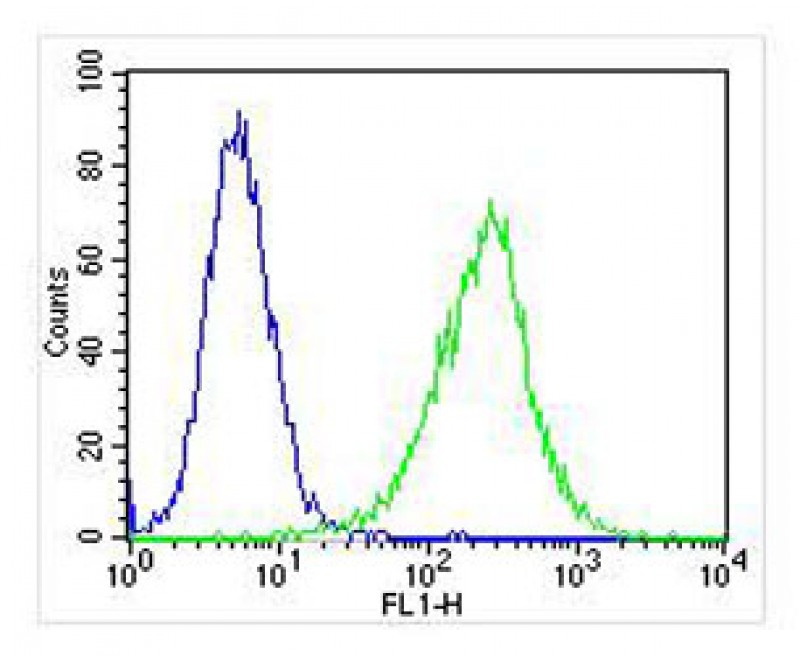
Mouse Anti-ZAP70 antibody
ZAP-70; ZAP 70; zeta-associated protein 70; ZAP-70=protein tyrosine kinase Syk homolog {SH2-like and C-terminal kinase domains}; Tyrosine-protein kinase ZAP-70; 70 kDa zeta-associated protein; Syk-related tyrosine kinase. SRK; STD; TZK; ZAP70_HUMAN; Tyros
View History [Clear]
Details
Product Name ZAP70 Chinese Name zeta相关蛋白70单克隆抗体 Alias ZAP-70; ZAP 70; zeta-associated protein 70; ZAP-70=protein tyrosine kinase Syk homolog {SH2-like and C-terminal kinase domains}; Tyrosine-protein kinase ZAP-70; 70 kDa zeta-associated protein; Syk-related tyrosine kinase. SRK; STD; TZK; ZAP70_HUMAN; Tyrosine-protein kinase ZAP-70; 70 kDa zeta-chain associated protein. Research Area Tumour Cell biology Signal transduction transcriptional regulatory factor Kinases and Phosphatases The cell membrane受体 t-lymphocyte Immunogen Species Mouse Clonality Monoclonal Clone NO. V4R3 React Species Human, Applications WB=1:500-2000 Flow-Cyt=1:25 ICC=1:25 IF=1:25
not yet tested in other applications.
optimal dilutions/concentrations should be determined by the end user.Theoretical molecular weight 68kDa Cellular localization cytoplasmic The cell membrane Form Liquid Concentration 1mg/ml immunogen Recombinant human ZAP70. Lsotype IgG1,k Purification affinity purified by Protein G Buffer Solution 0.01M TBS(pH7.4) with 1% BSA, 0.03% Proclin300 and 50% Glycerol. Storage Shipped at 4℃. Store at -20 °C for one year. Avoid repeated freeze/thaw cycles. Attention This product as supplied is intended for research use only, not for use in human, therapeutic or diagnostic applications. PubMed PubMed Product Detail This gene encodes an enzyme belonging to the protein tyrosine kinase family, and it plays a role in T-cell development and lymphocyte activation. This enzyme, which is phosphorylated on tyrosine residues upon T-cell antigen receptor (TCR) stimulation, functions in the initial step of TCR-mediated signal transduction in combination with the Src family kinases, Lck and Fyn. This enzyme is also essential for thymocyte development. Mutations in this gene cause selective T-cell defect, a severe combined immunodeficiency disease characterized by a selective absence of CD8-positive T-cells. Two transcript variants that encode different isoforms have been found for this gene. [provided by RefSeq, Jul 2008]
Function:
Tyrosine kinase that plays an essential role in regulation of the adaptive immune response. Regulates motility, adhesion and cytokine expression of mature T-cells, as well as thymocyte development. Contributes also to the development and activation of primary B-lymphocytes. When antigen presenting cells (APC) activate T-cell receptor (TCR), a serie of phosphorylations lead to the recruitment of ZAP70 to the doubly phosphorylated TCR component CD247/CD3Z through ITAM motif at the plasma membrane. This recruitment serves to localization to the stimulated TCR and to relieve its autoinhibited conformation. Release of ZAP70 active conformation is further stabilized by phosphorylation mediated by LCK. Subsequently, ZAP70 phosphorylates at least 2 essential adapter proteins: LAT and LCP2. In turn, a large number of signaling molecules are recruited and ultimately lead to lymphokine production, T-cell proliferation and differentiation. Furthermore, ZAP70 controls cytoskeleton modifications, adhesion and mobility of T-lymphocytes, thus ensuring correct delivery of effectors to the APC. ZAP70 is also required for TCR-CD247/CD3Z internalization and degradation through interaction with the E3 ubiquitin-protein ligase CBL and adapter proteins SLA and SLA2. Thus, ZAP70 regulates both T-cell activation switch on and switch off by modulating TCR expression at the T-cell surface. During thymocyte development, ZAP70 promotes survival and cell-cycle progression of developing thymocytes before positive selection (when cells are still CD4/CD8 double negative). Additionally, ZAP70-dependent signaling pathway may also contribute to primary B-cells formation and activation through B-cell receptor (BCR).
Subunit:
Interacts with NFAM1. Interacts with adapter proteins SLA and SLA2; these interactions negatively regulates T-cell receptor signaling. Interacts with CBLB (By similarity). Interacts with DEF6. Interacts (via SH2 domains) with RHOH; this interaction regulates ZAP70 subcellular localization (By similarity). Interacts with FCRL3. Interacts with VAV1. Interacts with CD247/CD3Z; this interaction docks ZAP70 at the stimulated TCR. Interacts with CBL; this interaction promotes ubiquitination, internalization and subsequent degradation of CD247/CD3Z. Identified in a complex with CBL and UBE2L3.
Subcellular Location:
Isoform 1: Cell membrane; Single-pass type I membrane protein. Endosome. Note=Autophosphorylation promotes ubiquitination and endocytosis;Isoform 2: Cytoplasm. Cell membrane; Peripheral membrane protein. Note=In quiescent T-lymphocytes, it is cytoplasmic. Upon TCR activation, it is recruited at the plasma membrane by interacting with CD247/CD3Z. Co-localizes together with RHOH in the immunological synapse. RHOH is required for its proper localization to the cell membrane and cytoskeleton fractions in the thymocytes.
Tissue Specificity:
Expressed in T- and natural killer cells. Also present in early thymocytes and pro/pre B-cells.
Post-translational modifications:
Phosphorylated on tyrosine residues upon T-cell antigen receptor (TCR) stimulation. Phosphorylation of Tyr-315 and Tyr-319 are essential for ZAP70 positive function on T-lymphocyte activation whereas Tyr-292 has a negative regulatory role. Within the C-terminal kinase domain, Tyr-492 and Tyr-493 are phosphorylated after TCR induction, Tyr-492 playing a negative regulatory role and Tyr-493 a positive. Tyr-493 is dephosphorylated by PTN22.
DISEASE:
Selective T-cell defect (STCD) [MIM:269840]: A form of severe combined immunodeficiency characterized by a selective absence of CD8+ T cells. Note=The disease is caused by mutations affecting the gene represented in this entry.
Similarity:
Belongs to the protein kinase superfamily. Tyr protein kinase family. SYK/ZAP-70 subfamily.
Contains 1 protein kinase domain.
Contains 2 SH2 domains.
SWISS:
P43403
Gene ID:
7535
Database links:Entrez Gene: 7535 Human
SwissProt: P43403 Human
Product Picture
Lane 1: Jurkat cell lysates
Lane 2: Molt-4 cell lysates
Primary: Anti-ZAP70 (SLM-51603M) at 1/4000 dilution
Secondary: IRDye800CW Goat Anti-Mouse IgG at 1/20000 dilution
Predicted band size: 68 kD
Observed band size: 68 kD
HeLa cell; 4% Paraformaldehyde-fixed; Triton X-100 at room temperature for 20 min; Blocking buffer (normal goat serum) at 37°C for 20 min; Antibody incubation with (ZAP70) monoclonal Antibody, Unconjugated (SLM-51603M) 1:25, 90 minutes at 37°C; followed by a conjugated Goat Anti-Mouse IgG antibody at 37°C for 90 minutes,Dylight554 Phalloidin(red) was used to stain the cell Cytoplasmic actin.The nuclear counter stain is DAPI (blue).Blank control:Jurkat.
Primary Antibody (green line): Mouse Anti-ZAP70 antibody (SLM-51603M)
Dilution: 1:25;
Isotype Control Antibody (blue line): Mouse IgG Secondary Antibody : Goat anti-mouse IgG-AF488
Dilution: 1:400 Protocol
The cells were fixed with 4% PFA (10min at room temperature)and then permeabilized with 90% ice-cold methanol for 20 min at-20℃.The cells were then incubated in 5%BSA to block non-specific protein-protein interactions for 30 min at room temperature .Cells stained with Primary Antibody for 30 min at room temperature. The secondary antibody used for 40 min at room temperature. Acquisition of 20,000 events was performed.
References (0)
No References
Bought notes(bought amounts latest0)
No one bought this product
User Comment(Total0User Comment Num)
- No comment





 +86 571 56623320
+86 571 56623320
 +86 18668110335
+86 18668110335

